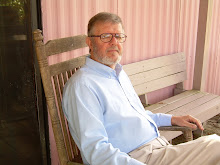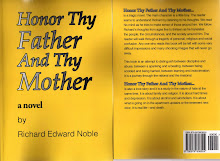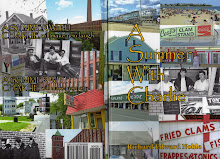The Eastpointer
A day on the winter bar
Richard E. Noble
Carol would sit up in our bed, rub her eyes, then pull back the curtain to our Airstream camper and peek out to see if the oyster bush was blowing in the wind. We spent the winter oystering on Cat Point which was right off shore from the campground where we stayed. If the oyster bush was whipping around or even fluttering, there was no sense in crawling out of our nice cozy bed. It would be too windy. There would be white caps on the water. The combination of cold and wind out on the bay was a killer.
I was raised in New England with the snow and cold but bought my first set of long underwear when I became an oysterman on Apalachicola Bay.
Very few oystermen rushed out early on those cold winter mornings. Most of them could be found along the shoreline warming their hands over a driftwood fire or downtown in one of the eateries having breakfast. It was the same in the orange groves in central Florida in January and February.
I had chest waders to get out to the boat in the winter. I took them off once I was on the boat and put them on to get back to shore after tying the boat out at the end of the day. Carol would always prepare hot coffee and sometimes soup and put them in a thermos. If it wasn’t soup, it would be something hot in the thermoses. In the morning she would fill the thermoses with hot water and get them good and hot before she put in the hot coffee and hot lunch. This technique worked pretty well.
To help with the cold and the wind, we used the two cull board technique. We would save an old cull board just for the winter time. We would set it up, lengthwise on the bow. The wind would blow it toward the culler and we would keep it up with guywire ropes attached to the bow post. That made a big difference. Some oystermen took hibachis out with them and stuck them under their cull board. We never liked the idea of hot coals on a wooden boat, so we roughed it out with our double cull boards.
In the fall and winter Carol always brought out an old fishing pole. She would bait it up with some fiddler crabs that she would scratch up while culling and then sit on the fishing pole handle as she culled. When she got her butt tickled, she would jump up and set the hook. We caught mostly sheepshead and drum fish and on a lucky day we might catch a flounder or a spotted trout. But nearly everyday Carol caught some fish. When our oystering day was over, I would use our walk rail as a cleaning table and fillet our catch. Then wash it down with bay water.
If it stayed overcast or cloudy all day, we would be mighty cold by the time we hit the dock. But oftentimes the sun would come out in the afternoon and warm us up.
In the old days Cat Point opened in September. For the most part the oysters would be small. If there were lots of spat and small oysters, that was a good sign. It would only take a few months for a small oyster to be harvestable. And by the last few months of the season we would even be harvesting those September spats. The growth rate for oysters in Apalachicola bay is phenomenal. I’ve read that in only seven to nine months an oyster spawn in Apalachicola Bay can grow to two and a half inches or more. It takes two to three years to grow an oyster to that size on either the east or west coast. That is one reason why it makes good sense for oystermen to catch clean oysters. The more small oysters and larger spats that they knock off the harvestable oysters, the more oysters they will be harvesting at the end of the season.
We had to watch the tide in the winter. If the wind was going to be blowing from the north all night, I would have to anchor my boat far off shore and hope that there would be some water under it in the morning. If I left the boat close to shore, there might be no water under my boat in the morning. And sometimes the water would not come back in for days.
In the evening when we brought in our catch, if the water had been blown out, we would have to haul the bags in on our shoulders one at a time, or wait until there was water around the dock that evening.
When I was forced to tie my boat out off shore, I used my hook anchor and I’d throw out a couple of loose crankshaft anchors just for safe keeping. We made our biggest money in the winter, harvesting in shore on the low tide. Sometimes the water would be so clear and shallow that you could see the oysters laying right there on the bottom. That saved a lot of guessing, pushing and shoving.
Richard Noble is a freelance writer and has been a resident of Eastpoint for 30 years. He has published 5 books and they are all for sale on Amazon. If you would like to stock his books in your store or business e-mail Richard at richardedwardnoble@gtcom.net.
skip to main |
skip to sidebar


G.E. Nordell's List of Labor History books
Search This Blog
Popular Posts
-
Bea’s Sandwich Shop Lawrence, Mass - My Hometown By Richard E. Noble Bea’s sandwich shop was a big memory for those of us...
-
John Pierpont Morgan 1837- 1913 By Richard E. Noble “Morgan the Magnificent - If ever there thrived a money potentate whose fortune was p...
-
Jews, God and History By Max I. Dimont Book Review By Richard Edward Noble Max I. Dimont is an ex-shoe salesman and unskilled la...
-
Social Security Commentary By Richard E. Noble The original Social Security legislation was passed in 1935. It covered employees w...
-
IF I WERE A BUTTERFLY By Richard E. Noble If I were a butterfly, I could flap my wings, and fly from flower to flower... Hour... upon hour ....
-
The Hobo Philosopher Rice Cakes – Yummy, Yummy. By Richard E. Noble My wife, over the past 30 years, has probably been on every di...
-
Politically Incorrect Humor/Commentary By Richard E. Noble Obviously, I grew up in the age of political incorrectness. Clearly I was raised ...
-
The Eastpointer Why do mullet jump? By Richard E. Noble Mullet has been a staple of life for decades here in Franklin County. Most other pl...
-
Lawrence – My Hometown Lennie’s on the Turnpike Richard E. Noble Being a jazz buff from early on my favorite nightspot was Lennie’s on the T...
-
Lawrence - My Hometown The Den Rock Drive-in By Richard E. Noble The Den Rock drive-in was on route 114 before the Den restaurant and pa...
Hobo Notes
Licensed book sellers and distributors - buy my books wholesale
Books by Richard Edward Noble. Click on covers below for more info and purchasing instructions.
Bloggin' Be My Life
It's All About Love
A Little Something
Bits and Pieces
A Baker's Dozen
Cat Point - and Them Dang Oyster People
The Eastpointer
A Summer with Charlie - Lawrence
Hobo-ing America
"Just Hangin' Out Ma"
That Old Gang of Mine
Come On-A My House
Standing on the Corner is # 6 in the lawrence My Hometown series.
Honor Thy Father and Thy Mother
Noble Notes on Famous Folks
Mein Kampf - An Analysis of Book One
America on Strike
Talk Radio - Lawrence, Ma. WCCM
Richard Edward Noble

About Me

- Richard Edward Noble
- MY NAME IS RICHARD EDWARD NOBLE. I AM A FREELANCE WRITER AND I HAVE PUBLISHED 12 BOOKS:"THE EASTPOINTER" - SELECTIONS FROM AWARD WINNING NEWSPAPER COLUMN - "A LITTLE SOMETHING" - POETRY WITH PROSE -"HONOR THY FATHER AND THY MOTHER" - A NOVEL ABOUT GROWING UP IN THE NEW ENGLAND MILL TOWN OF LAWRENCE, MASS, "HOBO-ING AMERICA" - A WORKINGMAN'S TOUR OF THE U.S.A. - "A SUMMER WITH CHARLIE" - THE STORY OF A YOUNG SAILOR'S LAST DAYS AT SALISBURY BEACH, "NOBLE NOTES ON FAMOUS FOLKS" - HUMOROUS ANECDOTES ON FAMOUS FOLKS IN HISTORY, "AMERICA ON STRIKE" HISTORY BOOK - A SURVEY OF LABOR STRIKES IN AMERICA; "A BAKER'S DOZEN" A BOOK OF HUMOROUS SHORT STORIES; "JUST HANGIN' OUT, MA" - GROWING UP IN THE 40'S, 50'S AND 60'S IN LAWRENCE, MY HOMETOWN, "TENEMENT DWELLERS" - SEQUEL TO JUST HANGIN OUT, MA; MEIN KAMPF - ANALYSIS OF BOOK ONE - HISTORY. CAT POINT - AND THEM DANG OYSTER PEOPLE - SEQUEL TO THE EASTPOINTER All 12 BOOKS ARE AVAILABLE ON AMAZON.COM, BARNES AND NOBLE AND OTHER INTERNET SOURCES OR FROM NOBLE PUBLISHING. ALL 12 OF MY BOOKS ARE NOW ON KINDLE AT BARGAIN PRICES TOO. IF YOU WOULD LIKE MORE INFORMATION ABOUT DISCOUNTS AND SPECIAL OFFERS E-MAIL ME. MY EMAIL IS ON MY PROFILE PAGE.
Robert Reich
Come Home America
Darcia Helle - "No Justice"
25 GreatThinkers Everybody Should Read
Followers
Writer's journal
My Blog List
Blog Archive
-
▼
2009
(127)
-
▼
February
(12)
- John Stuart Mill
- Lawrence - My HometownGoing to the RATSBy Richard ...
- The EastpointerA Carrabelle Cowboy and EvolutionBy...
- Lawrence - My HometownLittle CriminalsBy Richard E...
- A Day on the Winter Bar
- The EastpointerPay people as little as you can get...
- Ulysses Simpson Grant (Pr...
- Hegel
- Bea's Sandwich Shop
- Wooden Boats
- Medicare Advantage
- She Came to See Me
-
▼
February
(12)




































